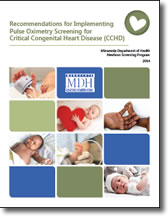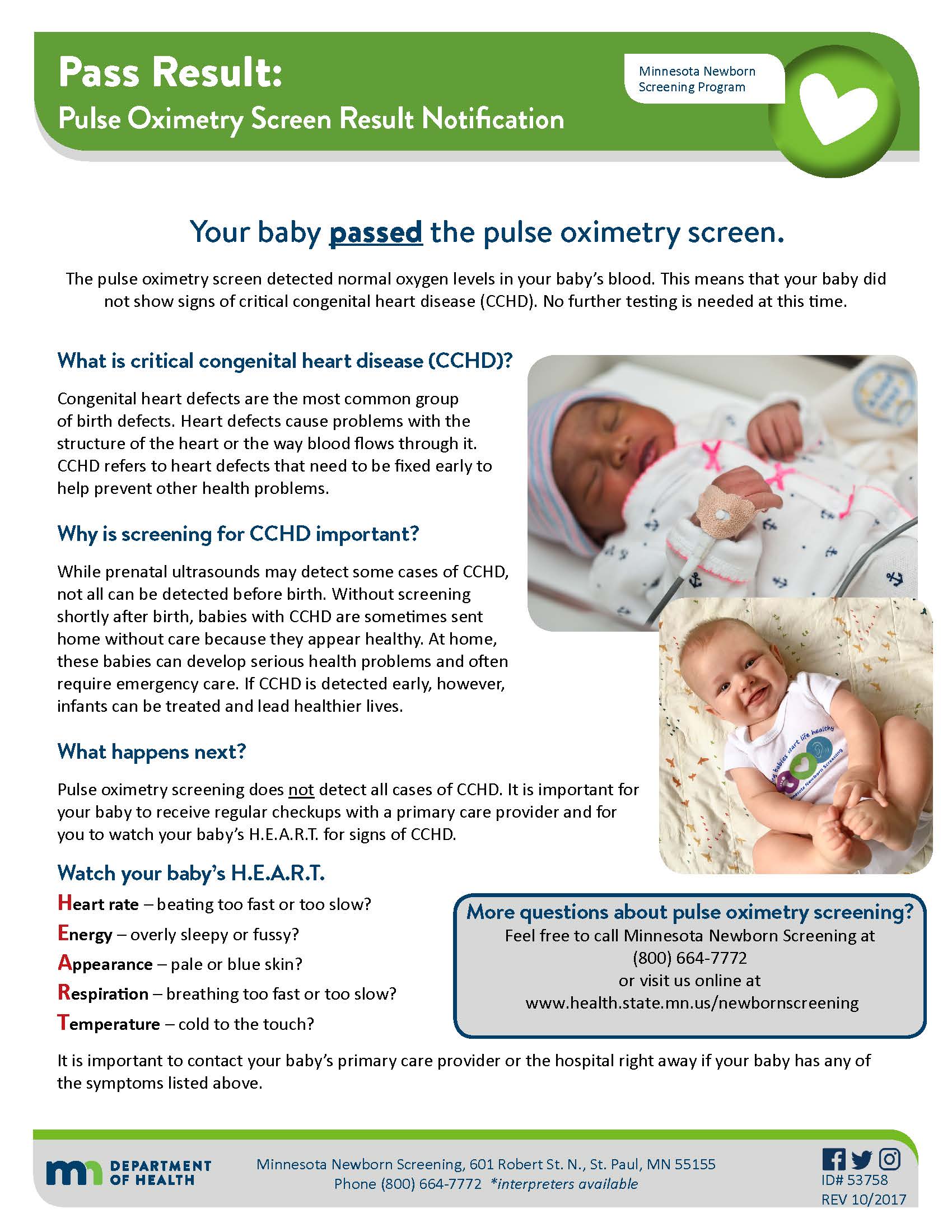Contact Info
Newborn Screening Information for Providers:
Pulse Oximetry Screening in the Well-Baby Nursery
VIDEO: Newborn Heart Screening
This video explains the importance of newborn pulse oximetry screening and reviews the basics of how providers can use pulse oximeters to screen for critical congenital heart disease (CCHD) in newborns. The video was made in collaboration with the University of Minnesota Masonic Children's Hospital and the Newborn Foundation.
Newborn Foundation Screening Video Text
Minnesota state law (Statute 144.1251) outlines the following responsibilities for all licensed hospitals and birthing centers in Minnesota:
- Communicate newborn pulse oximetry screening information and parental options to parents prior to screening
- Screen all infants for CCHD after 24 hours or as close as possible to the time of discharge if discharging before 24 hours, unless parents have signed the Parental Refusal or Delay of Newborn Screening form (found on the Education Materials and Forms (printable) page)
- Report all pulse oximetry results to the Minnesota Department of Health Newborn Screening Program through MNScreen
Screening should be performed by qualified personnel who have been trained in both newborn pulse oximetry screening and Minnesota’s recommended screening algorithm.
The following resources may be used for training screeners:
 Recommendations for Implementing Pulse Oximetry Screening for Critical Congenital Heart Disease (CCHD) packet (PDF) – designed by our program for Minnesota providers
Recommendations for Implementing Pulse Oximetry Screening for Critical Congenital Heart Disease (CCHD) packet (PDF) – designed by our program for Minnesota providers- Pulse Oximetry Screening Protocol for Critical Congenital Heart Disease (PDF)
- Newborn Heart Screening video (approx. 10 minutes) – produced through a collaboration between MDH, the Newborn Foundation, and the University of Minnesota Masonic Children's Hospital
- Basics of Screening for Critical Congenital Heart Disease** video (approx. 19 minutes) – produced by Wisconsin SHINE
- Pulse Oximetry Screening for Critical Congenital Heart Disease Online Learning Module** (includes 7 video modules, approx. 2-10 minutes each) – produced by Wisconsin SHINE
- Heart Smart: CCHD Screening for Parents** videos in English, Arabic, Chinese, French, Russian, and Spanish (approx. 6 minutes each)
**NOTE: These resources use a screening protocol that differs from the protocol recommended in Minnesota. Please refer to the Pulse Oximetry Screening Protocol for Critical Congenital Heart Disease (CCHD) handout for Minnesota's recommended protocol.
Providers are responsible for educating parents about pulse oximetry screening before screening takes place. Education materials to aid in the discussion about pulse oximetry screening are available free of charge and can be ordered on the Education Materials and Forms page. For more information on educating parents about newborn screening, including pulse oximetry screening, visit the Postnatal Education page.
Initial pulse oximetry screening is best performed between 24 and 48 hours of life for healthy term newborns. If early discharge is planned, screening should occur as close as possible to the time of discharge. Earlier screening may produce false positive results due to the newborn's transition from fetal to neonatal circulation and the stabilization of systemic oxygen saturation levels.
Birth facilities are responsible for selecting and securing pulse oximetry equipment for screening newborns for CCHD. A variety of pulse oximeters are available for use with newborns. Please contact our program staff with any questions regarding pulse oximeter options and their compatibility with MDH reporting systems. It is important to ensure that the selected equipment is compliant with national standards for screening newborns, including:
- Approval by the Food and Drug Administration (FDA) for use in newborns,
- Validation in low-perfusion conditions and provides accurate readings with movement,
- 2% root, mean-square accuracy, and
- Reporting of functional oxygen saturation.
Hospitals should choose a probe recommended by the pulse oximeter manufacturer for use with the device. Both disposable and reusable probes with a disposable foam wrap are available and acceptable for screening.
Masimo
52 Discovery
Irvine CA 92618
Phone: 949-297-7000
Email: customerorders@masimo.com
Medtronic/Covidien Nellcor
Medtronic
710 Medtronic Parkway
Minneapolis, MN 55432-5604
Phone: 763-514-4000
Toll-free" 800-633-8766
- Perform pulse oximetry screening when the baby is quiet and alert
- Measure oxygen saturations on the right hand and either right or left foot – measurements can be done at the same time or in direct sequence
- Ensure good pulse waveform for at least one full minute
Minnesota's Pulse Oximetry Screening Protocol for Critical Congenital Heart Disease (CCHD) (PDF)
All pulse oximetry screening results and follow-up arrangements should be conveyed to the newborn's parents and MDH. Results should be communicated with parents both verbally and in writing once the final screen is complete.
 Pass Result
Pass Result
If the infant receives a pass result, give the parent(s) the Pass Result: Pulse Oximetry Result Notification sheet and explain that pulse oximetry does not detect all cases of CCHD. Encourage parent(s) to contact their infant's primary care provider should concerns arise.
 Did Not Pass Result
Did Not Pass Result
If the infant receives a non-passing result, give the parent(s) the Did Not Pass Result: Pulse Oximetry Result Notification sheet and discuss what further evaluation and/or testing is needed and the timeframe for that testing.
Result notification sheets are available to order free-of-charge on the Education Materials and Forms page.
Recommended Follow-up for Did Not Pass Results
We recommend that providers take the following steps for any newborn with a non-passing pulse oximetry result:
- Perform a comprehensive evaluation for causes of hypoxemia
- If a non-cardiac explanation for the hypoxemia is not identified, CCHD must be excluded on the basis of a diagnostic echocardiogram
- A diagnostic echocardiogram should not be replaced by other cardiac evaluations (e.g., chest radiograph, electrocardiogram)
- It is recommended that the diagnostic echocardiogram occur within four hours of the final pulse oximetry screen
- A CME-credit approved Sonographer Education training is available to assist cardiac sonographers in performing the initial neonatal echocardiogram as part of a comprehensive evaluation for hypoxemia
- Pediatric cardiology specialists are available to consult on any non-passing pulse oximetry screen result and can help discuss stabilization and transport needs and/or provide interpretation of echocardiogram findings
- Echo Results should be sent to MDH using the Echocardiogram Result Report form
Reporting Results to MDH
Minnesota state law (Statute 144.1251) requires that all pulse oximetry screening results be reported to MDH. All results should be reported electronically using MNScreen.